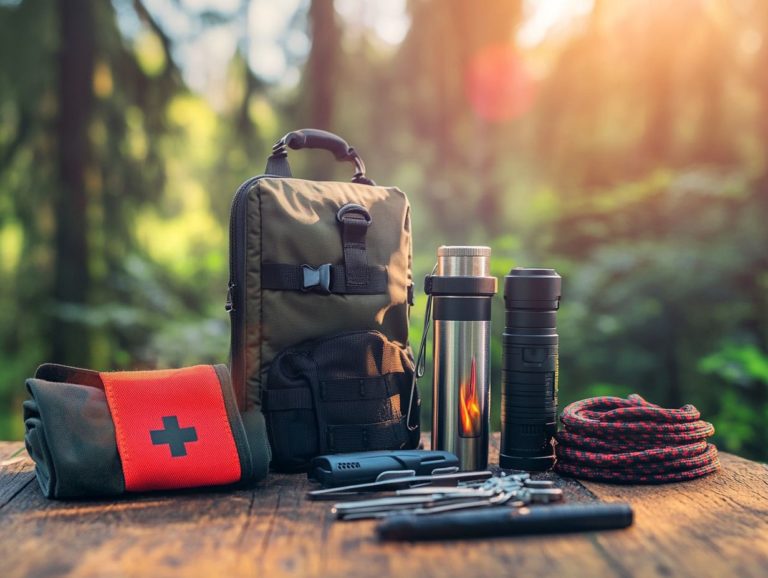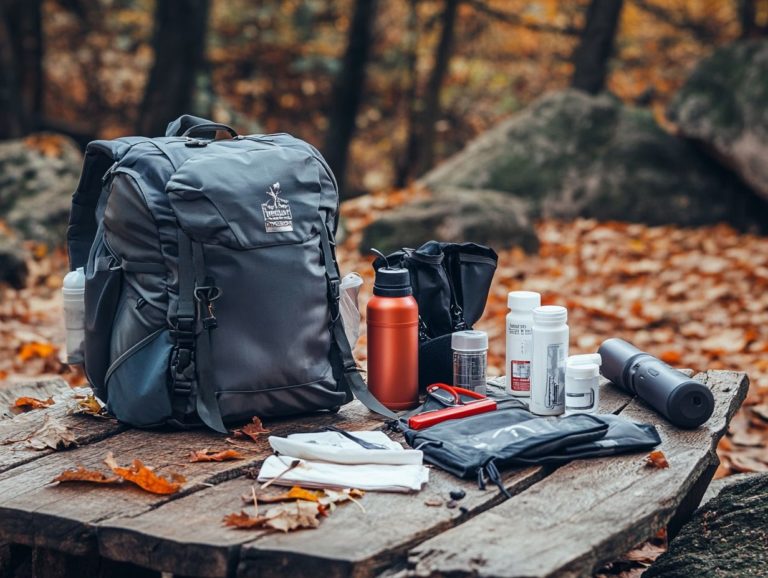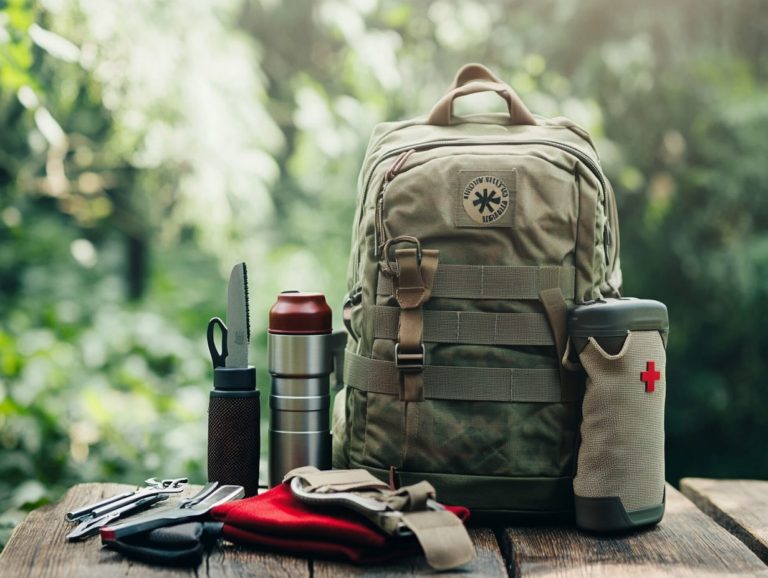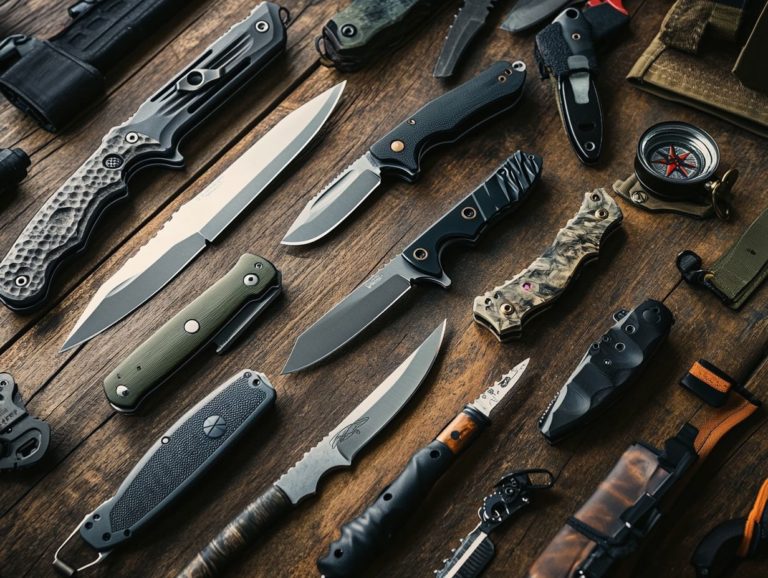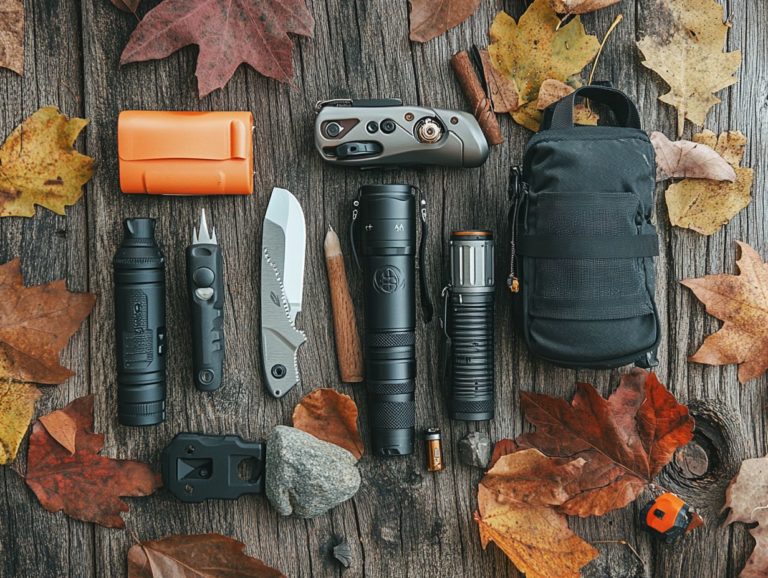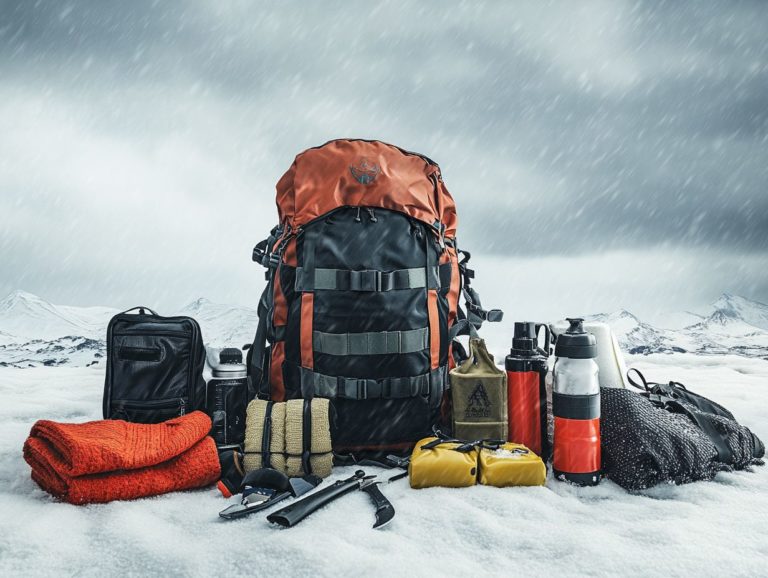Survival Gear for Remote Camping Destinations
When you venture into the wild, possessing the right survival gear can transform an unforgettable adventure into a challenging ordeal.
This article delves into the essential tools and equipment that every backcountry camper should consider, ranging from navigation aids and fire-making tools to personal protection gear and cooking equipment.
Whether you’re a seasoned expert or embarking on your first adventure, knowing what to bring will boost your safety and enjoyment in the great outdoors.
Get ready and gear up for your next thrilling adventure!
Contents
- Key Takeaways:
- 1. Navigation Tools
- 2. Shelter and Sleeping Gear
- 3. Fire-Making Tools
- 4. Water Filtration Systems
- 5. First Aid Kit
- 6. Multi-Tool
- 7. Cooking Equipment
- 8. Emergency Communication Device
- 9. Personal Protection Gear
- 10. Proper Clothing and Footwear
- 11. Insect Repellent
- 12. Survival Guide or Manual
- 13. Emergency Shelter
- 14. Solar Charger
- 15. Entertainment Items
- How to Choose the Right Gear for Your Needs?
- Frequently Asked Questions
- What type of survival gear is essential for remote camping destinations?
- How much water should I bring for a remote camping trip?
- Do I need to bring a GPS or navigation system for a remote camping trip?
- What type of shelter is best for a remote camping trip?
- How important is it to have a first aid kit for a remote camping trip?
- Is there any specific gear I should bring for protection against wildlife?
Key Takeaways:
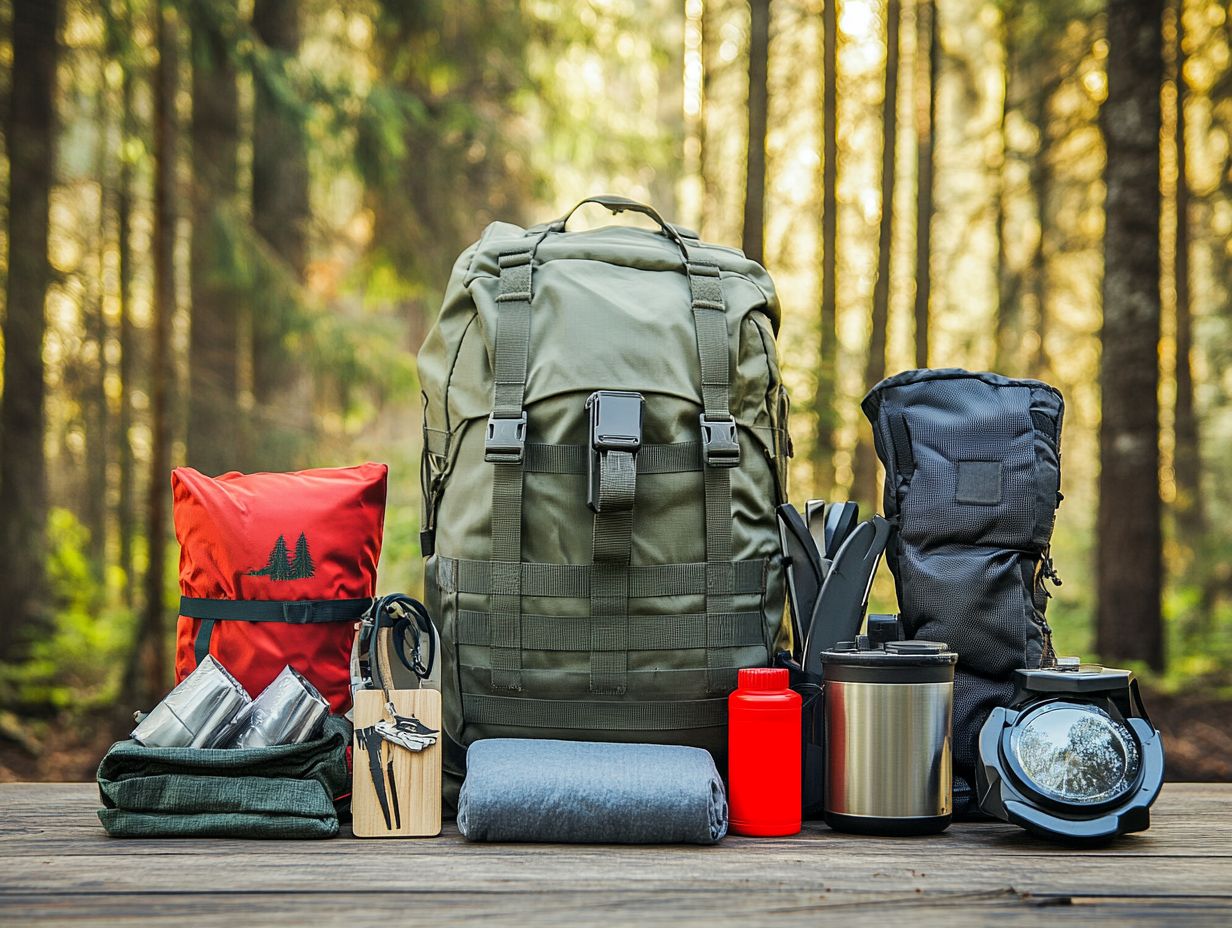
- Navigation tools are essential for remote camping, including a compass, map, and GPS device, to ensure you can find your way back to camp or seek help if needed.
- Shelter and sleeping gear, such as a tent, sleeping bag, and sleeping pad, are crucial for staying warm and protected from the elements.
- Fire-making tools, such as matches, lighters, and fire starters, are important for cooking, warmth, and signaling for help in emergencies.
When you embark on primitive camping adventures, especially in large national parks or remote backcountry locales, having reliable navigation tools is key to ensuring a safe and enjoyable experience. These tools guide you along hiking trails and help with effective adventure planning.
Selecting the right navigation tool will enhance your experience, whether you choose a handheld GPS device for precise positioning or a traditional topographic map for a more tactile approach. Compasses are invaluable allies when technology falters or in areas with challenging signal coverage. Maps excel in dense forests where GPS signals may be unreliable.
Preparation is key. Understand the terrain and expected conditions to choose the most suitable navigation aid. This foresight enhances safety and enriches your exploration experience.
2. Shelter and Sleeping Gear
Selecting the right shelter and sleeping gear is crucial for your comfort during primitive camping. Choose a sleeping bag tailored to the climate and ensure your campsite promotes a restful night s sleep.
As you venture into the wilderness, consider various shelter options tents, hammocks, and tarps all designed to protect you from the elements. Each type has its advantages, depending on your environment and personal preferences. Tents offer privacy and wind resistance, while hammocks provide a lighter, more versatile option in tree-dense areas.
Knowing how to choose a sleeping bag is essential. Pay attention to temperature ratings and insulation types to ensure warmth in colder conditions. Your campsite selection is equally important; aspects such as elevation, proximity to water sources, and potential hazards can significantly influence your safety and comfort at night.
3. Fire-Making Tools
Fire-making tools are critical for your primitive camping adventures. They provide warmth, cooking capabilities, and a comforting sense of security, all while requiring you to practice responsibility in line with leave no trace principles.
Embrace a range of fire-making techniques, from flint and steel to matches, to enhance your outdoor experience while keeping safety at the forefront. Flint and steel require skill and patience but offer reliability in damp conditions. While matches are convenient, store them properly to protect against moisture damage.
Modern fire starters can streamline the ignition process, making it easy to spark a flame when needed. Building fires in designated areas protects fragile ecosystems and fosters a sustainable relationship with nature. By championing the leave no trace ethos, you minimize impact, leaving the landscape as pristine as you found it.
Discover the best gear, and make your next camping trip unforgettable!
4. Water Filtration Systems
In backcountry camping, having an effective water filtration system is essential for ensuring safe hydration. It should be a key item on your packing list.
Consider options like the Sawyer filter, which provides a portable solution for accessing clean water from natural sources. You have a variety of choices beyond just this popular filter. Purification tablets are an excellent lightweight solution for eliminating harmful microorganisms in water, making them ideal for trips where space is at a premium. Another option is UV light devices; these devices use ultraviolet rays to kill germs and bacteria in water quickly and efficiently.
By understanding your specific camping conditions such as the proximity to contaminated water sources and weighing your preferences for weight versus effectiveness, you can make an informed decision on the right hydration system to enhance your adventures.
5. First Aid Kit
A well-stocked first aid kit is your safety net in the wild, serving as a vital resource for emergency preparedness and granting you peace of mind while you relish the great outdoors.
Equipping yourself with the right items can truly make a difference in unforeseen circumstances. Your first aid kit should include a variety of bandages for cuts and scrapes, antiseptics to stave off infections, and pain relievers to ease any discomfort.
Depending on your specific needs, it might also be prudent to add items such as:
- Allergy medications: For unexpected allergic reactions.
- Splints: To stabilize sprains.
- Blister pads: Essential for long hikes to protect sore feet.
Customizing your kit based on the nature of your trip whether it s a family outing, a solo adventure, or a challenging hike boosts your safety and lets you enjoy your adventure to the fullest.
6. Multi-Tool
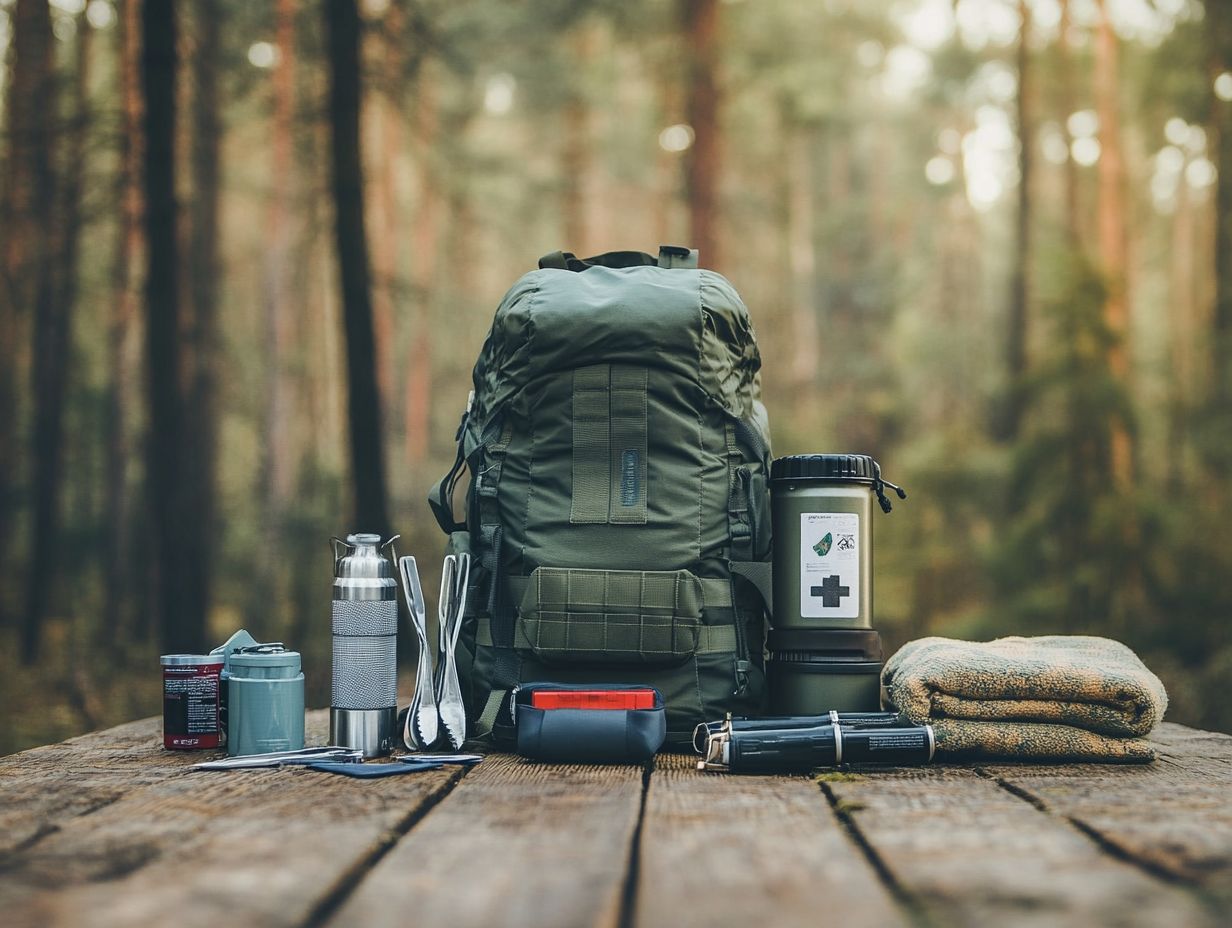
A multi-tool is an essential piece of camping gear that seamlessly blends functionality with portability, making it a must-have for your backcountry checklist, especially if you re a fan of brands like Osprey and REI.
Designed to tackle many tasks, this tool includes sharp knives for food preparation, strong screwdrivers for equipment repairs, and convenient can openers for quick access to canned supplies.
But it s not just about convenience; these multi-tools rise to meet the unpredictable challenges of outdoor adventures, whether you’re setting up camp or cooking under a canopy of stars.
When faced with a stubborn screw or needing to slice through rope, the compact design of a multi-tool allows you to carry it effortlessly, ensuring that all your camping needs are met without the hassle of juggling multiple items.
7. Cooking Equipment
Don’t head into the wild without the right cooking gear! Cooking equipment plays a pivotal role in your primitive camping adventures, giving you the power to whip up nutritious meals with ease while ensuring effective food storage to minimize waste.
Having the right tools can elevate your outdoor cooking experience dramatically. Essential items like portable stoves, available in a variety of fuel types, provide the necessary heat for your culinary creations, while lightweight pots make cooking and cleanup a breeze.
Equipping yourself with basic utensils think spatulas, knives, and multi-tools will ensure that meal prep flows smoothly, whether you re nestled at a campsite or navigating more rugged terrain.
Meal planning is key; incorporating freeze-dried meals not only lightens your food supply but also offers quick and nutritious options for those busy days spent in the great outdoors.
8. Emergency Communication Device
An emergency communication device, like a weather radio, is critical for your backcountry camping expeditions. It keeps you updated on vital weather conditions and safety information, ensuring you’re well-informed while you embrace the great outdoors.
When embarking on remote adventures, the value of satellite phones and GPS locators cannot be overstated; they significantly bolster your safety measures. Satellite phones allow you to make critical calls, no matter the state of cellular coverage, whether you need to reach emergency services or simply update loved ones on your status.
On the other hand, GPS locators come with SOS features that can send distress signals in emergencies, pinpointing your exact location. Using these tools gives you peace of mind and allows you to navigate safely. These tools make your camping trips more fun and way less stressful!
9. Personal Protection Gear
Personal protection gear is essential for you as a camper, serving as a safeguard against wildlife encounters and environmental hazards. This commitment aligns with the principle of leaving no trace. It also enhances your enjoyment of nature.
Equipping yourself with the right gear not only makes your time outdoors better, but it also elevates your experience, allowing you to immerse yourself in the beauty of the wilderness with peace of mind.
Key items to consider include:
- Bear spray, a critical deterrent for potential bear encounters.
- Sturdy, appropriate footwear to help you navigate rocky terrains and wet conditions.
- Sun protection like sunscreen and wide-brimmed hats, which are crucial for preventing sunburn and heat exhaustion.
By integrating these protective elements into your camping adventures, you can minimize risks and embrace a mindset of responsible outdoor practices.
10. Proper Clothing and Footwear
Proper clothing and footwear are important parts of your camping gear, expertly designed to keep you comfortable and shielded from the elements especially when informed by a reliable weather radio.
The choice of materials can significantly enhance your outdoor experience, as they directly impact insulation and keeping you dry. For example, opting for fabrics with excellent insulation properties ensures you stay warm during those chilly nights, while waterproof materials provide a crucial defense against unexpected rain. Breathability is equally important; it allows sweat to escape, keeping you dry and free from discomfort.
As you plan your outfit, don’t underestimate the power of layering. Incorporate moisture-wicking base layers, insulating mid-layers, and outer shells to protect you from wind and rain. Flexibility is key when adapting to changing weather conditions, so be ready to adjust your layers as temperatures fluctuate throughout the day.
11. Insect Repellent
Insect repellent is a must-have item on your camping checklist, especially for backcountry adventures, as it protects against bites and elevates your overall outdoor experience.
Selecting the right type of repellent can greatly influence your comfort and safety. You’ll find a range of options available sprays, lotions, and wipes each with its own distinct advantages.
- Sprays are typically easy to apply and offer comprehensive coverage.
- Lotions can provide a soothing sensation on your skin.
When choosing a product, look for effective active ingredients like DEET, which is a common ingredient in insect repellents that helps keep bugs away, Picaridin, or oil of lemon eucalyptus; these are tried-and-true solutions for keeping pests at bay.
To maximize the effectiveness of these products, apply them only to exposed skin and clothing, taking care to avoid your face to reduce irritation. By following these guidelines, you ensure optimal protection and pave the way for a more enjoyable camping adventure. Get ready for your adventure by packing these essentials now!
12. Survival Guide or Manual
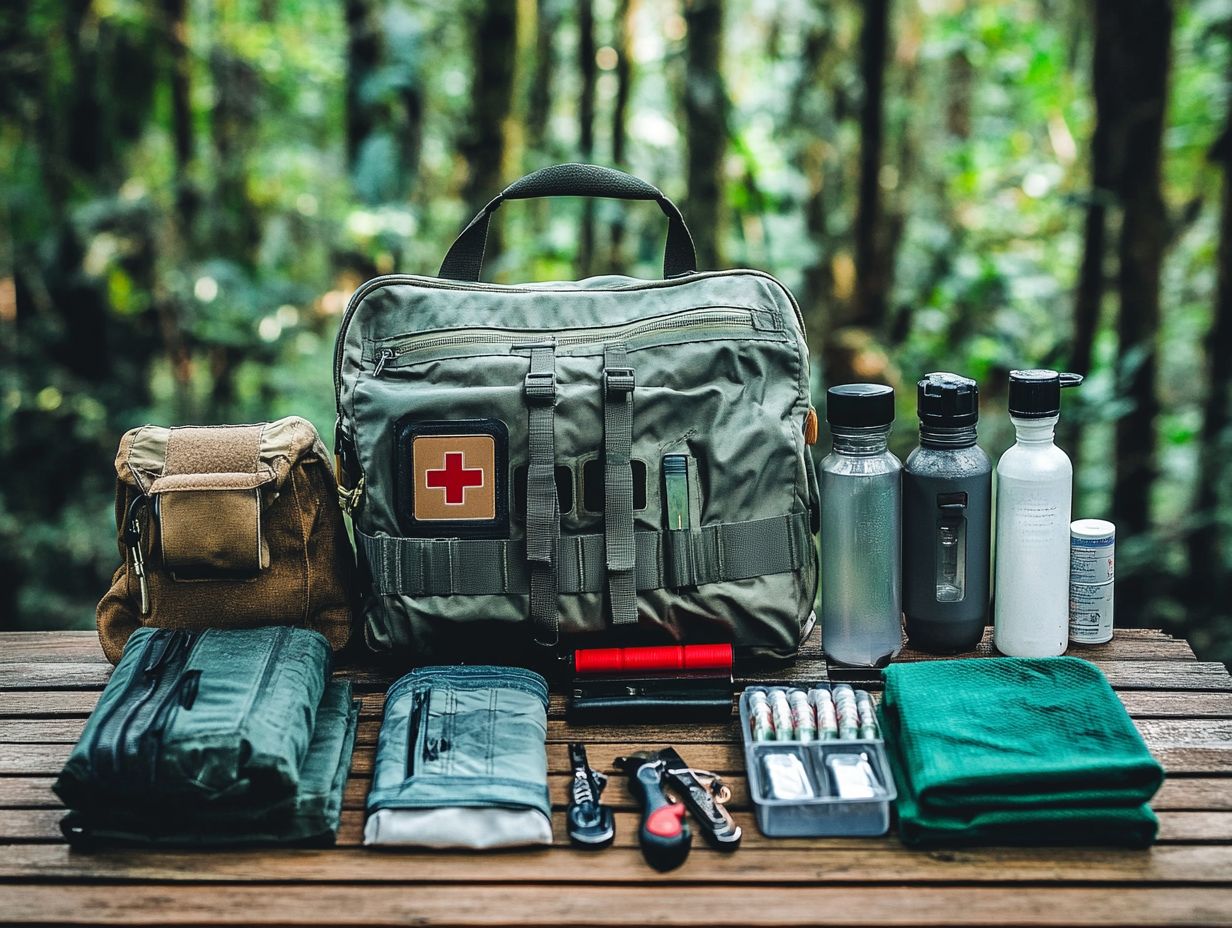
A survival guide or manual is an invaluable asset in your camping arsenal. It equips you with essential wilderness skills and knowledge for planning safe adventures.
These guides cover critical topics like navigation techniques using a compass and map, foraging for edible plants to keep your energy up, and fundamental first aid methods for addressing any injuries or ailments that may arise in the wild. By immersing yourself in these key areas, you can significantly boost your confidence.
Whether you encounter challenging weather conditions or need to assist an injured companion, having access to this vital information can turn a potentially stressful situation into a manageable one. This preparation can lead to a more enjoyable and fulfilling outdoor experience, allowing you to fully embrace the beauty of nature.
13. Emergency Shelter
An emergency shelter is an essential piece of camping gear for primitive camping. It provides you with crucial protection from the elements while staying true to leave no trace principles.
These shelters come in various forms, each tailored to different situations and preferences. Bivy bags are a compact and lightweight choice, making them ideal for solo adventurers. They offer warmth and protection from rain and wind without taking up much space. Alternatively, tarps can be remarkably versatile, allowing you to create a makeshift roof over your camping area with ease.
Mastering how to set up your shelter can be a game changer in the wild! Proper setup involves securing the shelter with sturdy stakes or natural anchors, ensuring stability against unpredictable weather. This setup allows for quick disassembly when it’s time to hit the road again.
14. Solar Charger
A solar charger is an excellent eco-friendly addition to your camping gear. It provides a renewable source of power for your devices and solar-powered lights.
This versatile tool not only reduces your reliance on traditional energy sources but also helps you minimize your carbon footprint. When selecting the right solar charger, consider factors like power level and how long it lasts to ensure it meets your charging needs during extended trips.
Opt for lightweight and foldable options for enhanced portability, making packing a breeze. To maximize efficiency, position the charger in direct sunlight and steer clear of shaded areas.
Regularly checking for clean surfaces will optimize energy absorption, allowing you to stay connected and powered throughout your outdoor experiences.
15. Entertainment Items
Bringing entertainment items into your camping gear is essential for enhancing your adventure planning. These leisure activities not only fill the downtime but also elevate your experience with delicious Trail Mix that fuels your adventures!
These items can truly enrich your overall camping experience, allowing you to unwind beneath the stars. Imagine getting lost in a captivating book or engaging in friendly competition with portable games among friends or family. Musical instruments, such as a guitar or ukulele, can transform your campfire into a vibrant gathering spot for sing-alongs and storytelling sessions.
By incorporating these elements, you foster deeper connections and promote relaxation. Pack your favorite games and get ready for an unforgettable camping experience!
How to Choose the Right Gear for Your Needs?
Choosing the right gear for your camping needs is essential for a successful adventure. It requires thoughtful consideration of your personal preferences and a well-crafted camping checklist.
Start by evaluating your specific needs, like the number of campers and the duration of your trip. Think about the activities you plan to engage in whether that s hiking, fishing, or simply soaking in the beauty of nature.
Next, take a close look at the weather and landscape. This will guide your selection process, ensuring that your gear is perfectly suited for the surroundings. Researching both the location and the latest gear innovations is crucial.
This attention to detail enhances your comfort and promotes safety throughout your adventure. It ultimately allows for a more enjoyable experience.
Frequently Asked Questions
What type of survival gear is essential for remote camping destinations?
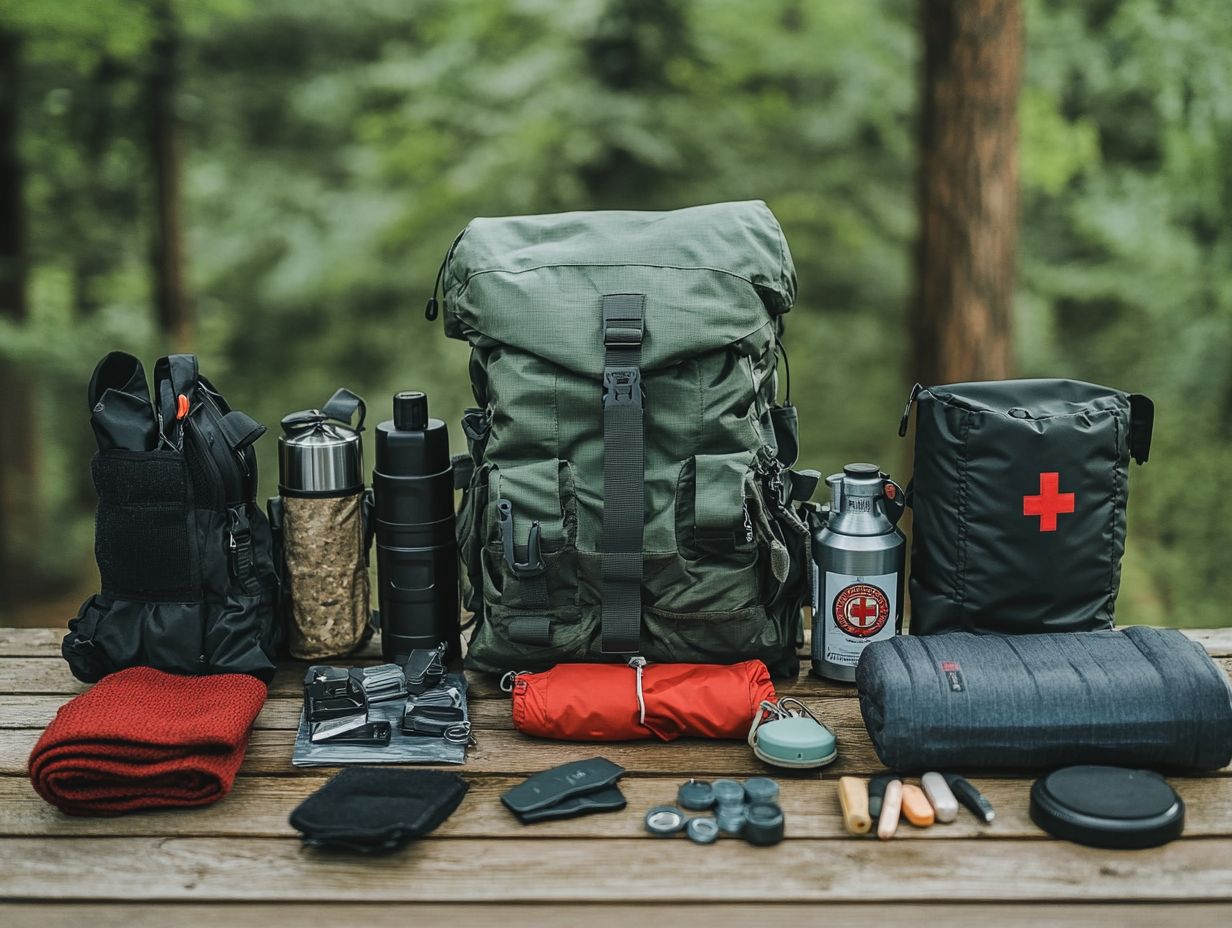
For remote camping, pack a first aid kit, a water filter, a fire starter, a reliable shelter, and a multi-tool a tool that combines multiple functions. These items are crucial for your safety and comfort.
How much water should I bring for a remote camping trip?
Bring at least one gallon of water per person, per day. Adjust this based on trip length and local water sources.
Don t head out without a GPS or a map and compass! This can make all the difference in finding your way through unfamiliar terrain.
What type of shelter is best for a remote camping trip?
The type of shelter will depend on the environment and weather conditions. A tent is a popular and versatile option, but a tarp and hammock combo can also be effective for lightweight travel.
How important is it to have a first aid kit for a remote camping trip?
A first aid kit is a crucial piece of survival gear. It helps treat minor injuries and illnesses, providing essential tools for more serious situations until professional medical help can be reached.
Is there any specific gear I should bring for protection against wildlife?
Depending on the location, bring bear spray or other deterrents against wildlife. Research the area and its potential risks beforehand.

